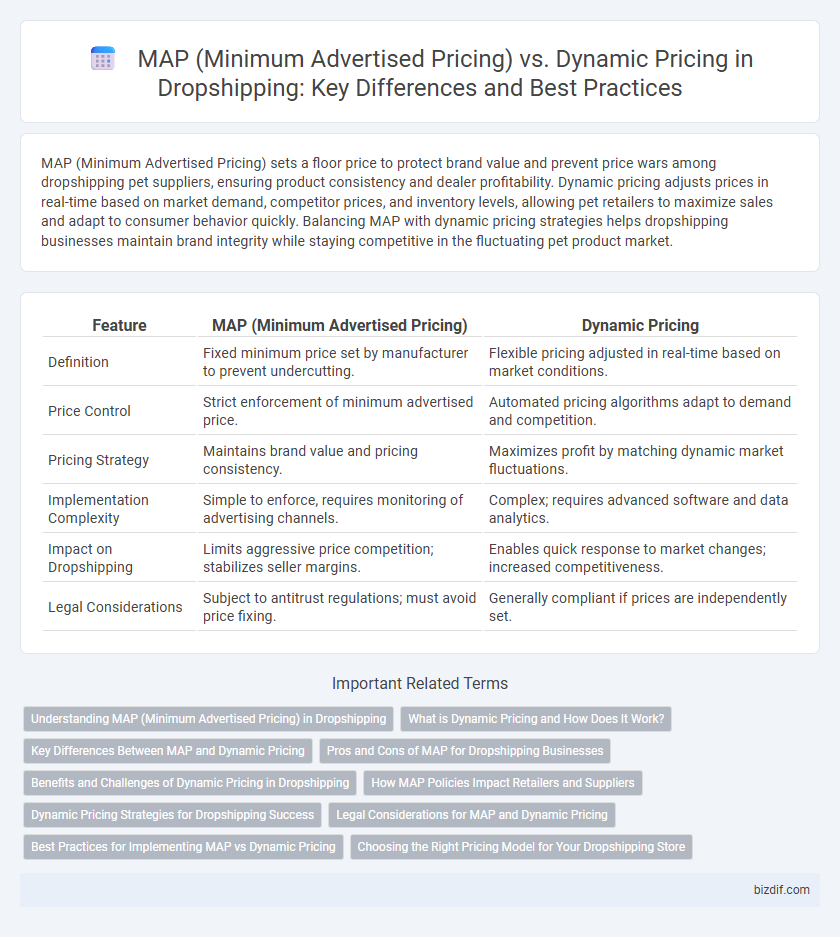MAP (Minimum Advertised Pricing) sets a floor price to protect brand value and prevent price wars among dropshipping pet suppliers, ensuring product consistency and dealer profitability. Dynamic pricing adjusts prices in real-time based on market demand, competitor prices, and inventory levels, allowing pet retailers to maximize sales and adapt to consumer behavior quickly. Balancing MAP with dynamic pricing strategies helps dropshipping businesses maintain brand integrity while staying competitive in the fluctuating pet product market.
Table of Comparison
| Feature | MAP (Minimum Advertised Pricing) | Dynamic Pricing |
|---|---|---|
| Definition | Fixed minimum price set by manufacturer to prevent undercutting. | Flexible pricing adjusted in real-time based on market conditions. |
| Price Control | Strict enforcement of minimum advertised price. | Automated pricing algorithms adapt to demand and competition. |
| Pricing Strategy | Maintains brand value and pricing consistency. | Maximizes profit by matching dynamic market fluctuations. |
| Implementation Complexity | Simple to enforce, requires monitoring of advertising channels. | Complex; requires advanced software and data analytics. |
| Impact on Dropshipping | Limits aggressive price competition; stabilizes seller margins. | Enables quick response to market changes; increased competitiveness. |
| Legal Considerations | Subject to antitrust regulations; must avoid price fixing. | Generally compliant if prices are independently set. |
Understanding MAP (Minimum Advertised Pricing) in Dropshipping
Minimum Advertised Pricing (MAP) in dropshipping is a policy set by manufacturers to control the lowest price retailers can publicly advertise their products, ensuring brand value and preventing price wars. This strategy helps maintain fair competition among resellers and protects profit margins by limiting aggressive discounting in online marketplaces. Understanding MAP is crucial for dropshippers to comply with supplier agreements and avoid penalties while balancing competitive pricing strategies.
What is Dynamic Pricing and How Does It Work?
Dynamic pricing is a strategy that adjusts product prices in real time based on market demand, competitor activity, and customer behavior using advanced algorithms and AI tools. This approach enables dropshipping businesses to remain competitive by optimizing prices dynamically, maximizing revenue without violating MAP (Minimum Advertised Pricing) policies that set the lowest price retailers can publicly advertise. By continuously analyzing sales data and market trends, dynamic pricing helps sellers respond instantly to fluctuations, improving inventory turnover and profit margins.
Key Differences Between MAP and Dynamic Pricing
MAP (Minimum Advertised Pricing) enforces a fixed minimum price set by manufacturers that resellers cannot advertise below, ensuring consistent brand value and preventing price wars. Dynamic pricing adjusts prices frequently based on market demand, competitor pricing, and customer behavior, enabling flexible and competitive pricing strategies in real-time. The key difference lies in MAP maintaining price floor stability, while dynamic pricing prioritizes adaptability for maximizing sales and profit margins.
Pros and Cons of MAP for Dropshipping Businesses
MAP (Minimum Advertised Pricing) ensures consistent pricing across dropshipping channels, protecting brand value and preventing price wars that can erode profit margins. However, it limits pricing flexibility, making it harder for dropshippers to react to market fluctuations or competitor discounts quickly. Compliance enforcement can also be challenging, potentially straining supplier-retailer relationships and complicating multi-channel selling strategies.
Benefits and Challenges of Dynamic Pricing in Dropshipping
Dynamic pricing in dropshipping enables sellers to adjust prices in real-time based on market demand, competitor pricing, and inventory levels, enhancing competitiveness and maximizing profit margins. This strategy improves responsiveness to market fluctuations but requires advanced data analytics and automation tools, which can increase operational complexity and cost. Unlike MAP policies that enforce fixed minimum prices, dynamic pricing offers flexibility but risks alienating suppliers or customers if prices fluctuate too frequently or appear inconsistent.
How MAP Policies Impact Retailers and Suppliers
MAP policies enforce strict price floors, protecting brand value and ensuring fair competition among retailers by preventing price undercutting. Retailers must adhere to supplier-set minimum advertised prices, limiting discounting flexibility but maintaining consistent market positioning. Suppliers benefit from MAP by safeguarding profit margins and maintaining product exclusivity, yet face challenges when enforcing compliance across diverse sales channels.
Dynamic Pricing Strategies for Dropshipping Success
Dynamic pricing strategies in dropshipping enable sellers to adjust prices in real-time based on market demand, competition, and inventory levels, maximizing profit margins and sales volume. Unlike MAP policies that set a fixed minimum price, dynamic pricing leverages data analytics and automation tools to respond swiftly to price fluctuations, ensuring competitive edge and customer satisfaction. Implementing AI-driven dynamic pricing algorithms optimizes product visibility and conversion rates while minimizing the risk of price wars and inventory stockouts.
Legal Considerations for MAP and Dynamic Pricing
Minimum Advertised Pricing (MAP) policies legally restrict the lowest price a reseller can advertise, ensuring brand value and fair competition, but must comply with antitrust laws to avoid price-fixing allegations. Dynamic pricing adjusts product prices in real-time based on demand, competitor pricing, and inventory levels, but must avoid deceptive practices or discriminatory pricing that violate consumer protection laws. Understanding and adhering to these legal frameworks is crucial for dropshippers to maintain compliance while optimizing pricing strategies.
Best Practices for Implementing MAP vs Dynamic Pricing
Implementing MAP (Minimum Advertised Pricing) requires strict adherence to supplier guidelines to maintain brand consistency and avoid channel conflicts, ensuring advertised prices never undercut the agreed minimum. Dynamic pricing leverages real-time data analytics, competitor pricing, and demand fluctuations to optimize profit margins and inventory turnover, demanding continuous monitoring and agile price adjustments. Best practices include combining MAP enforcement with dynamic pricing tools that respect minimum thresholds while maximizing market responsiveness for competitive advantage.
Choosing the Right Pricing Model for Your Dropshipping Store
Selecting the right pricing model for your dropshipping store significantly impacts profit margins and customer perception. Minimum Advertised Pricing (MAP) enforces a baseline price to maintain brand value and prevent price erosion, ideal for niche or branded products. Dynamic Pricing leverages real-time market data and competitor analysis to optimize prices for attracting customers and maximizing sales volume, fitting for highly competitive markets and fast-moving inventory.
MAP (Minimum Advertised Pricing) vs Dynamic Pricing Infographic

 bizdif.com
bizdif.com